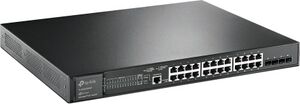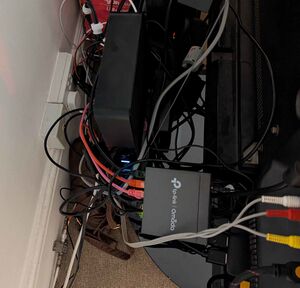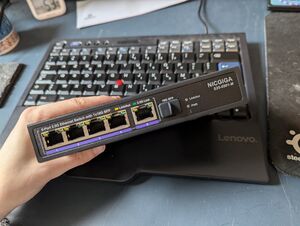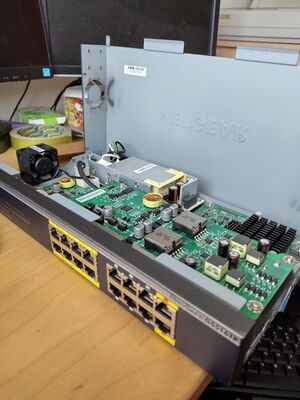Switches: Difference between revisions
No edit summary |
|||
| (12 intermediate revisions by the same user not shown) | |||
| Line 1: | Line 1: | ||
I use a number of network switches in my house and homelab, this page details all of them | I use a number of network switches in my house and homelab, this page details all of them | ||
== TL-SG3428XMP == | |||
[[File:TL-SG3428XMP.jpg|alt=TL-SG3428XMP Stock image|left|thumb|TL-SG3428XMP Stock image]]This is my new main switch, I've wanted it for a long while now. It is fully managed, optionally being integrated in the ''Omada'' ecosystem. | |||
It has 24 POE+ ports and 4 SFP+ 10 gigabit ports. It is rather loud with the included fans, so I replaced them both with 40mm Noctuas. It is notable that you can't wire them up in the default way or you get a fan error, thanks to [https://old.reddit.com/r/homelab/comments/r1yslv/anyone_done_a_tlsg3210xhpm2_fan_replacement_before/igy8eve/ this guy on reddit] for describing the solution. | |||
It powers a bunch of important stuff of POE, like [[Routerbox]] my virtualized router, the [[Switches#NICGIGA+S25-0501-M|NICGIGA S25-0501-M]] 2.5Gb switch it uplinks to, and my ISP modem in another room. This is achieved by having the WAN network itself being a VLAN. | |||
== ES205G == | |||
[[File:PXL20241213210507090.jpg|thumb|ES205G and Modem are tucked away behind the TV. That way you can't normally see the horrible cable mess. Both are powered off POE using a 12v POE splitter]][[File:Switches 1.jpg|left|thumb|Stack of router and switches: [[Pfsense router|Netgate SG-1100]], [[Switches#TL-RP108GE|TP-Link TL-RP108GE]], [[Switches#Mikrotik CRS112-8P-4S-IN|Mikrotik CRS112-8P-4S-IN]], [[Switches#Mikrotik CRS310-8G+2S+|Mikrotik CRS310-8G+2S+]], and [[Switches#Mikrotik CSS610-8G-2S+IN|Mikrotik CSS610-8G-2S+IN]]]][[File:Nicgiga.jpg|left|thumb|NICGIGA S25-0501-M cheap 2.5 gigabit managed chinese switch]]This is (I believe) the cheapest managed switch that can integrate into the ''omada'' ecosystem. In conjunction with a POE to 12v adaptor, and a 12v to 5v DC to DC converter, this switch, in addition to my ISP provided modem, is powered off POE from the [[Switches#TL-SG3428XMP|TL-SG3428XMP]], thus enabling me to continue having internet in the event of a power cut since that switch is powered off a UPS. It lives next to my modem, hidden behind my TV in the living room. | |||
== Mikrotik CRS310-8G+2S+ == | |||
This is one of the few Mikrotik switches with 2.5Gb. I used it to replace the [[Switches#NICGIGA S25-0501-M|NICGIGA S25-0501-M]], to add additional 2.5Gb ports, and a second SFP+ port. It is mostly use to uplink to [[Routerbox|Routerbox,]] and the TP-Link [[Switches#TL-SG3428XMP|TL-SG3428XMP]] at their max speeds. It is capable of running both SwitchOS and RouterOS. I was very [https://www.reddit.com/r/mikrotik/comments/1ji8pg7/disappointed_by_the_power_consumption_of_the/ disappointed] with the high power consumption of this switch, it has a 40mm fan, and unlike it's older brother, the [[Switches#Mikrotik CSS610-8G-2S+IN|Mikrotik CSS610-8G-2S]], it cannot be default powered off POE, so I have to use a 24v POE splitter to power it. | |||
| | |||
| | |||
| | |||
==TL-RP108GE== | == TL-RP108GE == | ||
Perhaps my most interesting switch is this TP-Link TL-RP108GE. It is a (managed) switch that is itself powered off POE, and also has a passive POE output, in addition to a standard DC output jack. You can do all sorts of interesting things with this. | |||
== NICGIGA S25-0501-M == | |||
This is a cheap chinese managed 2.5 gigabit switch. Managed 2.5 gigabit switches with 10 gigabit uplinks aren't so easy to come by. Being a random no-name chinese switch means it has some quirks, for instance you have to press a button in the web UI to persist changes over reboots. And, at least on my unit, the last 2.5 gigabit port cannot be used at the same time as the 10 gigabit port. So i had to disable the former. | |||
==Mikrotik CRS112-8P-4S-IN== | |||
Currently unused. It's a fully managed POE+ Switch. It can even act as a router since it runs Mikrotik's RouterOS. I've done this in a pinch when I've been on the move, like when I was at RoboCup 2024 in Eindhoven. | |||
==Mikrotik CSS610-8G-2S+IN== | ==Mikrotik CSS610-8G-2S+IN== | ||
The Mikrotik CSS610-8G-2S+in has two 10 gigabit SFP+ ports, it's currently unused. | |||
[[File:New switch opened.jpg|thumb|Netgear GS516TP Switch (opened up)]] | [[File:New switch opened.jpg|thumb|Netgear GS516TP Switch (opened up)]] | ||
| Line 95: | Line 30: | ||
== Netgear GS108PE == | == Netgear GS108PE == | ||
Currently unused. This switch requires a horrible buggy java desktop app to manage. But at least you can manage it at all I suppose. | |||
Latest revision as of 21:50, 17 April 2025
I use a number of network switches in my house and homelab, this page details all of them
TL-SG3428XMP
This is my new main switch, I've wanted it for a long while now. It is fully managed, optionally being integrated in the Omada ecosystem.
It has 24 POE+ ports and 4 SFP+ 10 gigabit ports. It is rather loud with the included fans, so I replaced them both with 40mm Noctuas. It is notable that you can't wire them up in the default way or you get a fan error, thanks to this guy on reddit for describing the solution.
It powers a bunch of important stuff of POE, like Routerbox my virtualized router, the NICGIGA S25-0501-M 2.5Gb switch it uplinks to, and my ISP modem in another room. This is achieved by having the WAN network itself being a VLAN.
ES205G
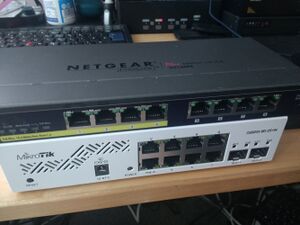
This is (I believe) the cheapest managed switch that can integrate into the omada ecosystem. In conjunction with a POE to 12v adaptor, and a 12v to 5v DC to DC converter, this switch, in addition to my ISP provided modem, is powered off POE from the TL-SG3428XMP, thus enabling me to continue having internet in the event of a power cut since that switch is powered off a UPS. It lives next to my modem, hidden behind my TV in the living room.
Mikrotik CRS310-8G+2S+
This is one of the few Mikrotik switches with 2.5Gb. I used it to replace the NICGIGA S25-0501-M, to add additional 2.5Gb ports, and a second SFP+ port. It is mostly use to uplink to Routerbox, and the TP-Link TL-SG3428XMP at their max speeds. It is capable of running both SwitchOS and RouterOS. I was very disappointed with the high power consumption of this switch, it has a 40mm fan, and unlike it's older brother, the Mikrotik CSS610-8G-2S, it cannot be default powered off POE, so I have to use a 24v POE splitter to power it.
TL-RP108GE
Perhaps my most interesting switch is this TP-Link TL-RP108GE. It is a (managed) switch that is itself powered off POE, and also has a passive POE output, in addition to a standard DC output jack. You can do all sorts of interesting things with this.
NICGIGA S25-0501-M
This is a cheap chinese managed 2.5 gigabit switch. Managed 2.5 gigabit switches with 10 gigabit uplinks aren't so easy to come by. Being a random no-name chinese switch means it has some quirks, for instance you have to press a button in the web UI to persist changes over reboots. And, at least on my unit, the last 2.5 gigabit port cannot be used at the same time as the 10 gigabit port. So i had to disable the former.
Mikrotik CRS112-8P-4S-IN
Currently unused. It's a fully managed POE+ Switch. It can even act as a router since it runs Mikrotik's RouterOS. I've done this in a pinch when I've been on the move, like when I was at RoboCup 2024 in Eindhoven.
Mikrotik CSS610-8G-2S+IN
The Mikrotik CSS610-8G-2S+in has two 10 gigabit SFP+ ports, it's currently unused.
Netgear GS516TP
Currently unused. This switch is rather old now, it draws 10-15W with nothing attached! Interestingly it can itself be powered off POE+.
Netgear GS108PE
Currently unused. This switch requires a horrible buggy java desktop app to manage. But at least you can manage it at all I suppose.
